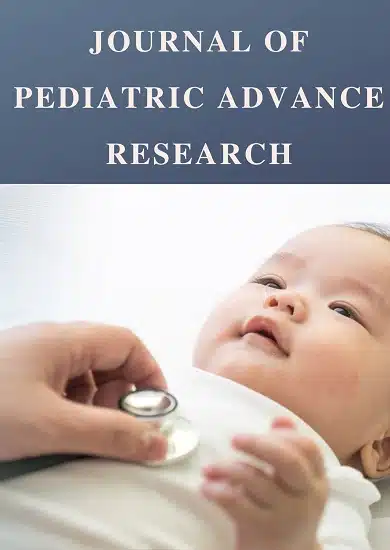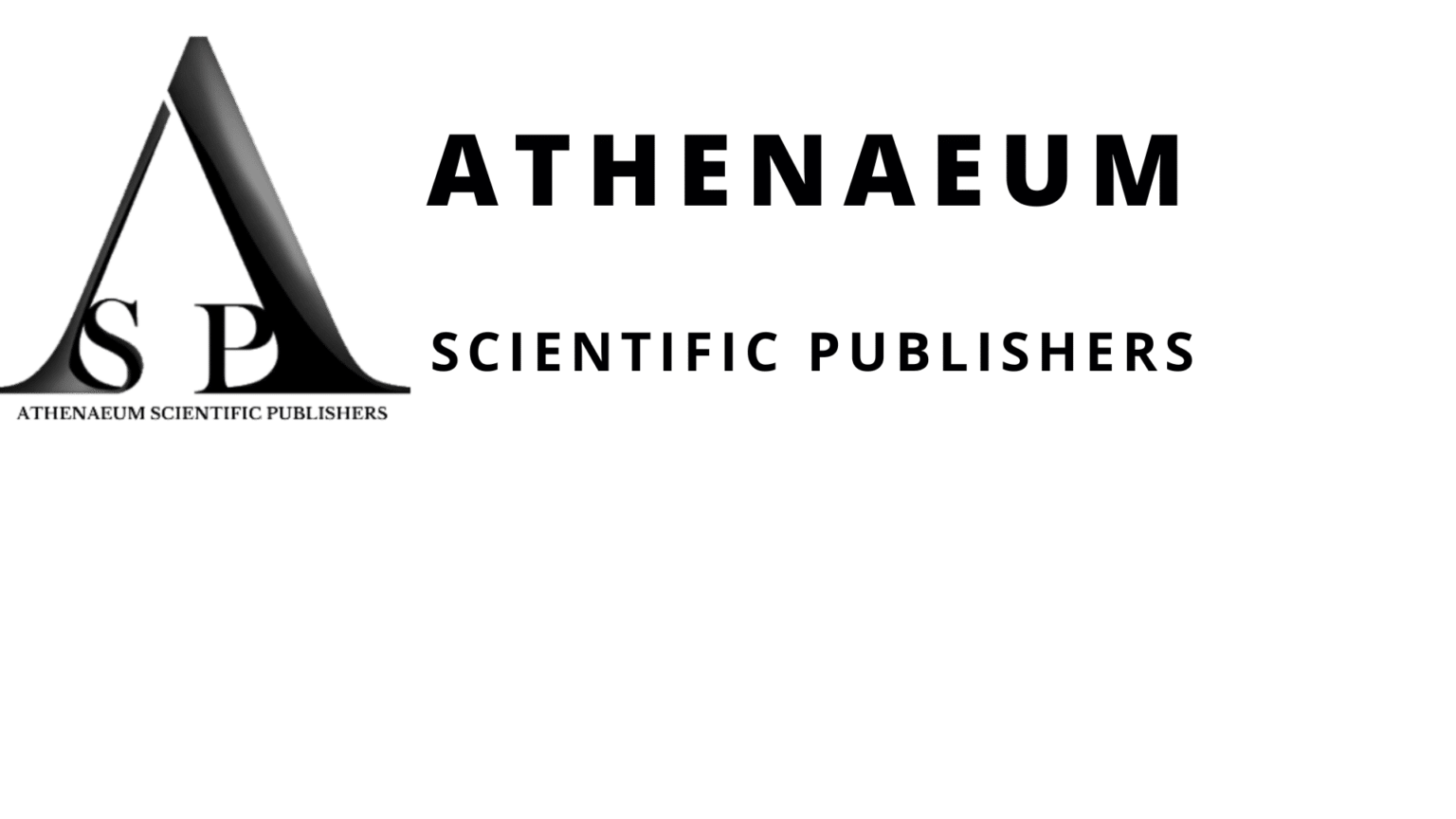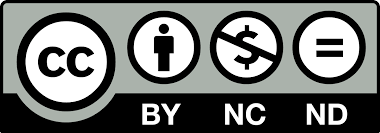Case Report | Vol. 4, Issue 1 | Journal of Pediatric Advance Research | Open Access |
Eighteen Months of Effective Treatment with Golimumab Monotherapy in a Child with Newly Diagnosed Type 1 Diabetes Mellitus, Case Report and Review of Literature
Manal Mustafa1*
1Arab Board in Pediatrics, Fellowship in Pediatric Endocrinology, Consultant Pediatric Endocrinologist, Al Jalila Children’s Hospital, Dubai, United Arab Emirates
*Corresponding author: Manal Mustafa, MD, MRCPCH, Arab Board in Pediatrics, Fellowship In Pediatric Endocrinology, Consultant Pediatric Endocrinologist, Al Jalila Children’s Hospital, Dubai, United Arab Emirates;
Email: [email protected]
Citation: Manal M. Eighteen Months of Effective Treatment with Golimumab Monotherapy in a Child with Newly Diagnosed Type 1 Diabetes Mellitus, Case Report and Review of Literature. J Pediatric Adv Res. 2025;4(1):1-12.
Copyright© 2025 by Manal M. All rights reserved. This is an open access article distributed under the terms of the Creative Commons Attribution License, which permits unrestricted use, distribution, and reproduction in any medium, provided the original author and source are credited.
| Received 29 March, 2025 | Accepted 21 April, 2025 | Published 28 March, 2025 |
Abstract
Type 1 Diabetes Mellitus (T1DM) is an endocrine disorder resulting from the deterioration of pancreatic beta cells by the body’s immune system, impairing insulin production. The present paper is a case report where the patient is a 5-year-old girl with newly diagnosed T1DM treated with Golimumab, a TNF-α inhibitor. Golimumab monotherapy was started and its use persisted for 18 months. The treatment rendered it to maintain near normoglycemic levels, preserving C-peptide and deferred use of insulin without any side effects. It, therefore, indicates that Golimumab works through neutralising TNF-α, a cytokine generally involved in the inflammation processes that cause beta cell destruction. Compared to other TNF-α inhibitors, including infliximab and etanercept, there are indications that these drugs may also protect beta cells. Still, the long-term advantages and risks may not be the same. Given the above findings, more comparative trials are still required to establish the optimum and least hazardous TNF-α inhibitor for T1DM patients.
Keywords: Type 1 Diabetes Mellitus; Golimumab; TNF-α Inhibitor; Beta Cell Preservation; Insulin Dependence; Autoimmune Destruction; Glycemic Control
Introduction
T1DM is an autoimmune disease where the body’s immune system attacks the pancreas and destroys the insulin-producing cells called beta cells, beginning with the onset of insulin deficiency [1]. New technologies in insulin administration and methods of measuring blood sugar levels still prevent most patients from maintaining satisfactory levels of glycemic control. Thus, of particular importance is the development of novel interventions to protect residual beta cell function, decrease the level of insulin dependence and enhance the general clinical profile of T1DM [2].
The disease is multifactorial, which means that it follows several causes. Therefore, T1DM relates to genetic predisposition, the environment and the immune system’s efficacy [3]. T and B lymphocytes are the main part of this process, which helps initiate the autoimmune response against beta cells. Also, other molecules from the innate immune system, including neutrophils, influence the inflammatory process that destroys the beta-cell [4]. T helper biting cells release pro-inflammatory cytokines, particularly Tumour Necrosis Factor-alpha (TNF-α), that are central to the onset and course of beta-cell autoimmunity. TNF alpha is a cytokine that increases inflammation, activates lymphocytes and causes toxicity directly to the beta-cell through endoplasmic reticulum stress. Therefore, the inhibition of TNF-α has become one of the main approaches for treating and regulating autoimmune processes and preserving beta cell function in T1DM [5].
Golimumab is a monoclonal antibody derived from human IgG1-κ. It is in the family of TNF-α blockers that have been employed in the retardation of numerous autoimmune diseases in adults as well as children [6]. Golimumab got approval in 2013 and it is used for rheumatoid arthritis, psoriatic arthritis, ankylosing spondylitis, non-invasive axial spondyloarthritis and ulcerative colitis in adults [7]. In children over two years of age, Golimumab is recommended for use in polyarticular juvenile idiopathic and psoriatic arthritis [8]. The self-administrated subcutaneous route is a convenient feature that goes with the utility of the medication for chronic treatment.
Based on the aforementioned positive outcomes, attention has been shifted towards investigating the extended treatment course effects and side effects of Golimumab in T1DM. To the best of our knowledge, this is the first-ever case in the literature of a child with newly diagnosed T1DM who received Golimumab monotherapy for 18 months. From this case, the usefulness of Golimumab can be inferred to help maintain beta-cell integrity and enhance the clinical as well as metabolic characteristics of pediatric T1DM patients. Also, this paper includes a thorough analysis of the literature on the impact of TNF- α antagonism in T1DM autoimmunity. It proposes further research in applying anti-TNF-α agents for type 1 diabetes treatment.
We evaluated monotherapy with Golimumab in a 5-year-old child recently diagnosed with T1DM and kept on it for 18 months. For this reason, this specific case provides a unique perspective on the long-term effects of Golimumab therapy in real life. The patient’s clinical history, metabolic problems and any side effects seen during the intervention will all be included in the following section. In addition, it is important to concentrate on the latest research that bolsters the use of TNF-α antagonists in T1DM, examining the potential mechanisms, benefits and drawbacks.
Case Report
This clinical case relates to a currently 6-year-old girl who has a primary diagnosis of newly diagnosed Type 1 Diabetes Mellitus (T1DM). She presented with polydipsia and polyuria, which her mother noticed. Her randomly obtained blood sugar level of 315 mg/dL and an HbA1c of 6.5%. Anti-GAD Abs (Anti-Glutamic Acid Decarboxylase Antibodies) and Anti ZNT8 Abs (Anti-Zinc Transporter 8 Antibodies) were positive. At the initial presentation, the C-peptide level was 0.48 nmol/L (reference range: 0.37-1.47 nmol/L). The continuous glucose monitoring showed a TIR of 88% with an average glucose of 115mg/dl (Fig. 1). The patient’s family history revealed that the patient’s elder brother, who is currently 15 years old, developed T1DM at the age of 18 months and has been on an insulin pump with a good, stable BG level. The lab results showed that the patient had preserved pancreatic beta-cell function, as indicated by the C-peptide levels.
Case Report
This clinical case relates to a currently 6-year-old girl who has a primary diagnosis of newly diagnosed Type 1 Diabetes Mellitus (T1DM). She presented with polydipsia and polyuria, which her mother noticed. Her randomly obtained blood sugar level of 315 mg/dL and an HbA1c of 6.5%. Anti-GAD Abs (Anti-Glutamic Acid Decarboxylase Antibodies) and Anti ZNT8 Abs (Anti-Zinc Transporter 8 Antibodies) were positive. At the initial presentation, the C-peptide level was 0.48 nmol/L (reference range: 0.37-1.47 nmol/L). The continuous glucose monitoring showed a TIR of 88% with an average glucose of 115mg/dl (Fig. 1). The patient’s family history revealed that the patient’s elder brother, who is currently 15 years old, developed T1DM at the age of 18 months and has been on an insulin pump with a good, stable BG level. The lab results showed that the patient had preserved pancreatic beta-cell function, as indicated by the C-peptide levels.
Component | Ref Range | Diagnosis | Day 10 | 10 Weeks | 15 Weeks | 6 Months | 9 Months | 12 Months | 18 Months |
HbA1C | <5.7 % | 6.5 | – | – | 6.4 | 6.5 | 6.9 | 7.3 | 5.8 |
C-Peptide | 0.37 – 1.47 nmol/L | 0.48 | 0.48 | 0.99 | 0.55 | 0.73 | – | 0.65 | |
25 OH Vitamin D Total (D2+D3) | 30 – 100 ng/mL | 31.3 | 31.3 | – | 45.7 | – | – | 45.6 | – |
Total Protein | 6.1 – 7.5 g/dL | – | 7.1 | 7.3 | – | – | – | 7.7 | 7.0 |
Albumin | 3.8 – 5.4 g/dL | – | 4.7 | 4.7 | – | – | – | 4.8 | 4.3 |
Bilirubin, Total | 0 – 1.2 mg/dL | – | <0.1 | 0.1 | – | – | – | 0.22 | 0.2 |
Bilirubin, Direct | 0 – 0.4 mg/dL | – | <0.1 | 0.0 | – | – | – | – | – |
Bilirubin, Indirect | 0 – 0.8 mg/dL | – | Not Calculated | 0.1 | – | – | – | – | – |
SGOT (AST) | 0 – 52 U/L | – | 28 | 23 | – | – | 27 | 27 | 30 |
SGPT (ALT) | 0 – 39 U/L | – | 14 | 9 | – | – | 15 | 11 | 22 |
Alkaline Phosphatase | 0 – 269 U/L | – | 271 (H) | 252 | – | – | 252 | 255 | 218 |
GGT | 0 – 26 U/L | – | 17 | 17 | – | – | – | – | – |
Globulin | 2.8 – 3.4 g/dL | – | 2.4 (L) | 2.6 (L) | – | – | – | – | – |
Albumin/Globulin Ratio | 1.0 – 2.2 | – | 2.0 | 1.8 | – | – | – | – | – |
Sodium | 136 – 145 mmol/L | – | 136 | – | – | – | 133 (L) | 137 | 135 |
Potassium | 3.5 – 5.1 mmol/L | – | 4.5 | – | – | – | 4.2 | 4.3 | 4.1 |
Chloride | 97 – 107 mmol/L | – | 107 | – | – | – | 103 | 106 | 100 |
Bicarbonate (HCO3) | 17 – 27 mmol/L | – | 18.0 | – | – | 17.0 | 21 | 22 | |
Creatinine | 0.44 – 0.65 mg/dL | – | 0.5 | – | – | – | 0.40 | 0.36 | 0.42 |
Urea | 19.26 – 47.294 mg/dL | – | 43 | – | – | – | 43 | 41 | 38 |
Calcium | 8.8 – 10.8 mg/dL | – | 10.0 | – | – | – | 10.0 | 10.3 | 9.8 |
Varicella Zoster Virus IgG | <0.8 Index | – | 8.7 (H) | – | – | – | – | – | – |
Varicella Zoster Virus IgM | <0.9 Index | – | 0.2 | – | – | – | – | – | – |
QF TB Gold Plus | Negative | – | Negative | – | – | – | – | – | – |
Rubella IgM (German Measles) | <0.9 | – | 0.2 | – | – | – | – | – | – |
Rubella IgG (German Measles) | >12 | – | >100 | – | – | – | – | – | – |
Rubeola Virus IgG | <0.8 Index | – | 9.5 (H) | – | – | – | – | – | – |
Rubeola Virus IgM | <0.8 Index | – | 0.2 | – | – | – | – | – | – |
Hepatitis C Antibodies | Non-reactive | Non-reactive | Non-reactive | – | – | – | – | – | – |
Hepatitis B Surface Antigen | 0 – 0.9 | – | 0.33 | – | – | – | – | – | – |
WBC Count | 5.0 – 15.0 x10^3/uL | 6.2 | 13.1 | 10.5 | – | – | 7.1 | 7.3 | 6.8 |
RBC Count | 4.00 – 5.20 x10^6/uL | 4.8 | 4.76 | 4.63 | – | – | 4.9 | 4.82 | 4.7 |
Hemoglobin, Blood | 11.1 – 14.1 g/dL | 13.2 | 11.4 | 11.2 | – | – | 12.9 | 11.7 | 12.5 |
Hematocrit | 30.0 – 38.0 % | 40.2 | 34.5 | 34.5 | – | – | 39.6 | 35.5 | 38.2 |
MCV | 72.0 – 84.0 fL | – | 72.5 | 74.6 | – | – | – | 73.6 | – |
MCH | 25.0 – 29.0 pg | – | 23.9 (L) | 24.2 (L) | – | – | – | 24.2 | – |
Anti-GAD Antibodies | Negative | Positive (156.2 IU/mL) | – | – | – | – | – | – | Positive |
Anti-ZNT8 Antibodies | Negative | Positive (>500) | – | – | – | – | – | – | Positive |
Hepatitis C Antibodies | Non-reactive | Non-reactive | – | – | – | – | – | – | Non-reactive |
Insulin Autoantibodies (IAA) | <20 IU/mL | 12.1 | – | – | – | – | – | – | 14.2 |
Islet Cell Antigen 2 AB (IA2) | <28 U/mL | <2.5 | – | – | – | – | – | – | – |
Table 1: Laboratory results summary.
The lab results showed that the patient had preserved pancreatic beta-cell function, as indicated by the relatively stable C-peptide levels over time. However, the slight increase in HbA1c and hyperglycemia, particularly after high-glycemic index foods, suggests the need for closer monitoring and potential adjustments in the management plan.
The second clinic visit; CGM showed TIR 88%, average glucose 105 mg/dl and estimated HBA1c 5.9% (Fig. 1,2). Golimumab was started after the second clinic visit at an initial induction dose of 60 mcg/m² subcutaneously for the first two doses (at weeks 0 and 2). This was followed by a 30 mcg/m² maintenance dose at week 4 and every two weeks after that. The initiation of Golimumab formed a critical point in the management of the patient for mandatory screening for hepatitis B and C, TB testing, vaccination against VZV and measles, close monitoring of the glycemic status of the patient and liver and kidney function before and after the administration of Golimumab for early identification of the possible side effects. No pre-existing abnormalities were detected as a screening workup before initiating Golimumab.
The diagnosis was T1DM, but the management strategy differed from the standard insulin prescription to decrease blood glucose levels. Giving this patient Golimumab-an anti-TNF agent-was suggested to preserve whatever beta cell function may be left behind. Close follow-up clinical visits with continuous glucose monitoring showed a TIR of 88% with minimal periods of hyperglycemia and no hypoglycemic episodes (Fig. 1).
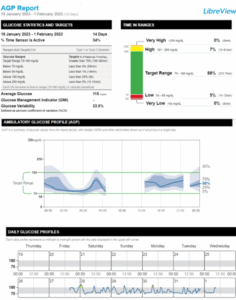
Figure 1: CGM on 1st visit at diagnosis.
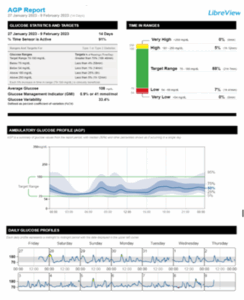
Figure 2: CGM after 10 days from diagnosis.
At the 3 months follow-up, the patient was stable and doing well on Golimumab injections alone. She still did not need insulin and mainly had normal blood sugar levels. The TIR averaged 90% with 6% in hyperglycemia and no true hypoglycemia was recorded (Fig. 3). Her average capillary blood glucose level was 115 mg/dL and her estimated HbA1c was 6.1%. Her vitamin D levels also rose from 31.3 ng/mL to 45. 7 ng/mL with supplementation. We decided to continue Golimumab injections every 2 weeks to save the remaining pancreatic beta cells and for the next follow-up in 3 months, including the HbA1c, C-peptide and the other labs.
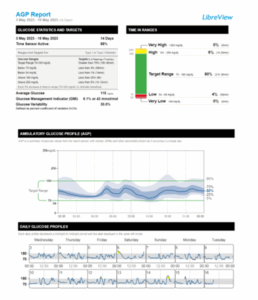
Figure 3: CGM after 3 months.
The next follow-up visit after 12 months from starting Golimumab; the patient was six years and two months old and had been receiving Golimumab monotherapy for almost one year. She was still doing well without any side effects, with 79% Time in Range and an estimated HbA1c of 6.3% (Fig. 4).
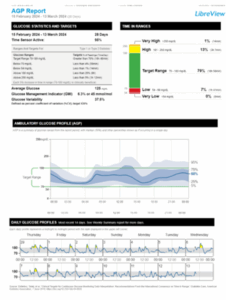
Figure 4: CGM after 12 months.
During the clinic visit after 18 months, the patient was 6-year-6-month-old. Her CGM showed a Time In Range (TIR) of 73%, 4% of hyperglycemia and no true hypoglycemia (not documented on blood, only through sensor), with an average blood sugar level of 103 mg/dL and an estimated HbA1c of 5.8% (Fig. 5). The patient continued to do very well on Golimumab and maintained almost normal blood sugar levels without requiring insulin (Fig. 6).
Throughout the follow-up, we ensured the family’s participation in the treatment, purposeful and informative use of the family to manage the disease and psychological support, which were also essential components of long-term care. In summary, during the 18 months Golimumab monotherapy treatment without insulin, the C-peptide level was maintained within the normal range, patient remained near normoglycemic with TIR within the target of > 70% and HBA1c in the acceptable range of maximum 7.3%.
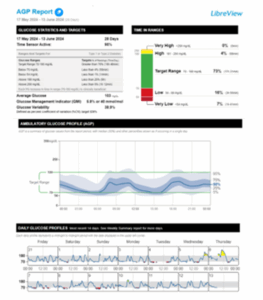
Figure 5: CGM after 18 months.
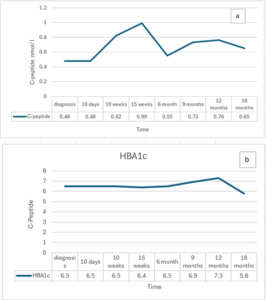
Figure 6: a: C-peptide levels during treatment course (Normal range for C-peptide 0.37 – 1.47 nmol/L); b: HbA1C levels during treatment course (Normal levels <5.7 %).
Clinical Discussion and Review of Literature
T1DM is a long-term chronic illness associated with the immune-mediated destruction of the beta cells in the pancreas, resulting in high blood glucose [4]. The conventional form of treatment entails insulin administration to regulate plasma glucose concentrations. However, the ongoing need for adjunct or additional forms of treatment has persisted to help maintain the cell activity of the pancreas’s beta cells and minimise the impacts of insulin therapy [9]. An example of such a treatment is Golimumab, a TNF inhibitor that has proven useful in treating other autoimmune diseases and has recently been considered in T1DM [10].
Safety of Golimumab and Type 1 Diabetes
Thus, Golimumab is a human monoclonal antibody that binds and prevents the action of TNF-alpha – an important cytokine in inflammation [10]. The drug is currently recommended for use in the treatment of several autoimmune disorders, among them rheumatoid arthritis, psoriatic arthritis, ankylosing spondylitis and juvenile idiopathic arthritis. The reason for employing Golimumab in T1DM originates from the part played by TNF-alpha in the inflammation process that destroys pancreatic beta cells [11].
The use of Golimumab in T1DM can be explained based on the impact of TNF-alpha on inflammation and destruction of pancreatic beta cells [11]. TNF-alpha is a pro-inflammatory cytokine identified as a decisive mediator of several autoimmune disorders, including T1DM. TNF-alpha has also been implicated in the induction of apoptosis in pancreatic beta cells; therefore, by tuning TNF-alpha activity, the drug may save the function of beta cells, which would be helpful in the treatment of diabetes [15]. Some modern researchers have considered the ability of TNF inhibitors for T1DM treatment. These observations imply that Golimumab may well constitute a new way of changing the outcome of T1DM if the treatment is started soon after diagnosis [16]. Sustaining the survival of beta cells is very important since it can enhance metabolic regulation, lessen the risk of low blood sugar and possibly delay some complications of diabetes [17].
New research has focused on the possible utility of TNF inhibitors in T1DM [18]. One single trial is a T1GER study aimed at assessing the effectiveness of Golimumab in pediatric patients with recently diagnosed T1DM. In conformity with the hypothesis, the results showed that Golimumab could conserve the beta cell function by raising C-peptide levels and lowering insulin dependence compared with the placebo group [19]. Based on these findings, it is postulated that through the administration of Golimumab, it is possible to positively change the prognosis of T1DM posit, especially in the early stages of T1DM.
Recent Case Reports and Clinical Trials
The current case report describes a 5-year-old pediatric patient with Type 1 Diabetes Mellitus who was treated successfully with Golimumab alone without insulin for 18 months duration and remained near normoglycemic with reserved C-peptide level within the normal range. Low HbA1c with normal C-peptide levels were later noted following the start of Golimumab therapy and she remained near normoglycemic with TIR within the target of > 70% without insulin for 18 months. Thus, this example demonstrates that Golimumab can improve beta cell function and maintain optimal glycemic control without insulin supplementation [20].
These research results are further supported by other large clinical trials, signifying that Golimumab can maintain the integrity of beta cells in newly diagnosed T1DM patients. The T1GER study also revealed similar results; patients in the Golimumab group had better glycemic control and maintained beta cell function compared to the placebo group [21]. These outcomes make a difference as they could strengthen the assumption that introducing Golimumab may enhance treatment results for T1DM patients with chronic pancreatitis and minimise insulin usage. The outcomes of the T1GER trial were positive and provided evidence that Golimumab treatment contributed to better conservation of endogenous insulin and human metabolic traits [22]. These outcomes indicate that Golimumab can influence the autoimmune action in T1DM and, therefore, can protect the beta-cells and enhance the general status of the patients. The trial also proved that Golimumab had a favourable safety profile as there were no reports of any adverse effect or risk factor associated with the drug [23].
Mechanism of Action
Golimumab affects TNF-α, a cytokine that plays a role in the inflammatory and immunological activity in T1DM. TNF-α attracts and mobilises immune cells to attack the pancreatic beta cells [24]. Since Golimumab inhibits the action of TNF-α, it mitigates inflammation and respective infiltration of immune cells in the pancreas, thus preserving beta cell integrity [25]. Evidence supporting this mechanism has been obtained by some studies that exhibit the effects of lesser apoptosis of the beta cells and enhanced TNF-α inhibitors in alpha and beta cells. In addition, compared to placebo, the increase of C-peptide levels by Golimumab ensures the continuation of endogenous insulin production, which is essential for improved glycemic regulation and reduced exogenous insulin usage in T1DM patients [26].
Comparison with Other TNF-α Inhibitors
Further studies of Golimumab in T1DM have proved to have beneficial impacts on the preservation of beta cell function [19]. However, the efficiency and safety of Golimumab have to be compared with other TNF-α inhibitors, including Infliximab and Etanercept. Infliximab, applied in many autoimmune diseases as a chimeric monoclonal antibody and Etanercept, applied as a soluble TNF receptor fusion protein, have not been adequately investigated in T1DM [27]. Based on the existing evidence, all TNF-α inhibitors appear to have some efficacy in preserving beta cells, but the long-term advantages and complications’ risks could be dissimilar. For instance, while using Infliximab, some patients have infusion reactions. While using Etanercept, some have reported Injection site reactions [28-37]. Thus, additional comparative research is still required to identify the most productive and safest TNF-α inhibitor for T1DM patients.
Recommendations
Managing T1DM in young children requires extra care when developing a care plan, especially when introducing new therapies such as Golimumab. The idea of postponing insulin use is employed to save the remaining functioning of Beta cells, which may change the course of the disease in the long run. Such an approach requires constant attention to the side effects and contraindications to minimise the risk of harming the patient or providing suboptimal care. Immunomodulatory therapy’s associated risks require vigilant case observations, periodical infection screening and metabolic tests.
Conclusion
This case report of 18-month monotherapy with Golimumab in a 5-year-old child not requiring insulin therapy with preservation of beta cell function, stable glycaemic control and no side effects suggests the possible treatment with a TNF-α inhibitor regimen, Golimumab, to manage newly identified T1DM sufferers. Based on such findings, the present study implies that early intervention with Golimumab can alter the disease progression by preserving beta cells from assault by the autoimmune system. Further researches are needed to validate these effects and create a protocol of regular TNF-α inhibitors for T1DM treatment with the help of a large-scale clinical trial.
Conflict of Interests
The authors have no conflict of interest to declare.
References
- Atkinson MA, Mirmira RG. The pathogenic “symphony” in type 1 diabetes: A disorder of the immune system, β cells and exocrine pancreas. Cell Metabolism. 2023;35(9):1500-18.
- Veelen A, Erazo-Tapia E, Oscarsson J, Schrauwen P. Type 2 diabetes subgroups and potential medication strategies in relation to effects on insulin resistance and beta-cell function: A step toward personalised diabetes treatment? Molecular Metabolism. 2021;46:101158.
- Zorena K, Michalska M, Kurpas M, Jaskulak M, Murawska A, Rostami S. Environmental factors and the risk of developing type 1 diabetes-old disease and new data. Biology. 2022;11(4):608.
- Roep BO, Thomaidou S, Van Tienhoven R, Zaldumbide A. Type 1 diabetes mellitus as a disease of the β-cell (do not blame the immune system?). Nature Reviews Endocrinology. 2021;17(3):150-61.
- Jo S, Fang S. Therapeutic strategies for diabetes: immune modulation in pancreatic β cells. Front Endocrinol. 2021;12:716692.
- Schreml S, Gollnick H. Systemic Therapy. In Braun-Falco´ s Dermatology. Springer. 2022;2037-74.
- Di Jiang C, Raine T. IBD considerations in spondyloarthritis. Therapeutic Advances in Musculoskeletal Disease. 2020;12:1759720X20939410.
- McIntosh SM, Kerut C, Hollenshead PP, Askins DH, Mansourian K, Palowsky ZR, et al. Golimumab for Polyarticular Juvenile Idiopathic Arthritis and Psoriatic Arthritis: Pharmacologic and Clinical Considerations. Life. 2023;13(7):1601.
- Prasathkumar M, Becky R, Anisha S, Dhrisya C, Sadhasivam S. Evaluation of hypoglycemic therapeutics and nutritional supplementation for type 2 diabetes mellitus management: an insight on molecular approaches. Biotechnology Letters. 2022;44(2):203-38.
- von Scholten BJ, Kreiner FF, Gough SC, von Herrath M. Current and future therapies for type 1 diabetes. Diabetologia. 2021;64:1037-48.
- Weiskorn J, Danne T. Moving from insulin substitution to the treatment of the underlying autoimmune disease in type 1 diabetes. Hormone Research in Paediatrics. 2024:1-8.
- Cetraro P, Plaza-Diaz J, MacKenzie A, Abadía-Molina F. A review of the current impact of inhibitors of apoptosis proteins and their repression in cancer. Cancers. 2022;14(7):1671.
- Dalle S, Abderrahmani A, Renard E. Pharmacological inhibitors of β-cell dysfunction and death as therapeutics for diabetes. Front Endocrinology. 2023;14:1076343.
- Weiskorn J, Danne T. Moving from insulin substitution to the treatment of the underlying autoimmune disease in type 1 diabetes. Hormone Research in Paediatrics. 2024:1-8.
- Moatti A, Cohen JL. The TNF-α/TNFR2 pathway: Targeting a brake to release the anti-tumor immune response. Frontiers in Cell and Developmental Biology. 2021;9:725473.
- Vallianou NG, Stratigou T, Geladari E, Tessier CM, Mantzoros CS, Dalamaga M. Diabetes type 1: can it be treated as an autoimmune disorder?. Reviews in Endocrine and Metabolic Disorders. 2021:1-8.
- Dilworth L, Facey A, Omoruyi F. Diabetes mellitus and its metabolic complications: the role of adipose tissues. Int J Molecular Sciences. 2021;22(14):7644.
- dos Santos Haber JF, Barbalho SM, Sgarbi JA, de Argollo Haber RS, de Labio RW, et al. The relationship between type 1 diabetes mellitus, TNF-α and IL-10 gene expression. Biomedicines. 2023;11(4):1120.
- Quattrin T, Haller MJ, Steck AK, Felner EI, Li Y, Xia Y, et al. Golimumab and beta-cell function in youth with new-onset type 1 diabetes. New England Journal of Medicine. 2020;383(21):2007-17.
- Granholm A, Alhazzani W, Derde LP, Angus DC, Zampieri FG, Hammond NE, et al. Randomised clinical trials in critical care: past, present and future. Intensive Care Medicine. 2022:1-5.
- Rigby MR, Hayes B, Li Y, Vercruysse F, Hedrick JA, Quattrin T. Two-year follow-up from the T1GER study: Continued off-therapy metabolic improvements in children and young adults with new-onset T1D treated with golimumab and characterization of responders. Diabetes Care. 2023;46(3):561-9.
- Pinheiro MM, Pinheiro FM, Garo ML, Pastore D, Pacifici F, Ricordi C, et al. Prevention and treatment of type 1 diabetes: in search of the ideal combination therapy targeting multiple immunometabolic pathways. Metabolism and Target Organ Damage. 2024;4(3).
- Wang CC, Tseng KS, Tsao YP, Chen WS, Lai CC, Sun YS, et al. Real-world effectiveness and safety of golimumab in rheumatoid arthritis treatment: a two-center study in Taiwan. J Chinese Medical Association. 2022;85(2):175-82.
- Sharma N, Kumari RM, Arya G, Gupta N, Chandra R, Nimesh S. Clinical trials of promising apoptosis modulating drugs. Clinical Perspectives and Targeted Therapies in Apoptosis. 2021;329-91.
- Liu J, Ting JP, Al-Azzam S, Ding Y, Afshar S. Therapeutic advances in diabetes, autoimmune and neurological diseases. Int J Molecular Sciences. 2021;22(6):2805.
- Kim YK, Munir KM, Davis SN. Type 1 diabetes: key drug targets and how they could influence future therapeutics. Expert Opinion on Therapeutic Targets. 2023;27(1):31-40.
- Ke QI, Kroger CJ, Clark M, Tisch RM. Evolving antibody therapies for the treatment of type 1 diabetes. Front Immunol. 2021;11:624568.
- Pilunni D, Santuccio C, Sottosanti L, Felicetti P, Navarra P. Relationship between injection site reactions and different adalimumab formulations. Analysis of the adverse events reported in Italy in 2016-2019. European Review for Medical and Pharmacological Sciences. 2021;25(8).
- Eguchi N, Vaziri ND, Dafoe DC, Ichii H. The role of oxidative stress in pancreatic β cell dysfunction in diabetes. International J Molecular Sciences. 2021;22(4):1509.
- Godfrey A, Aisharwya NM, Babiker B, Gitima D. Role of interleukin-1β in pancreatic islet cells dysfunction and apoptosis in pancreatic islet transplantation. Research J Pharmacy and Technology. 2020;13(8):3947-51.
- Hasan SA, Shajira ES. Lactic acidosis due to thiamine deficiency in a preterm infant associated with inadequate parenteral nutrition. The Am J Case Reports. 2023;24:e939008-1.
- Khilji MS, Verstappen D, Dahlby T, Burstein Prause MC, Pihl C, Bresson SE, et al. The intermediate proteasome is constitutively expressed in pancreatic beta cells and upregulated by stimulatory, low concentrations of interleukin 1 β. PloS One. 2020;15(2):e0222432.
- Korytkowski MT, Muniyappa R, Antinori-Lent K, Donihi AC, Drincic AT, Hirsch IB, et al. Management of hyperglycemia in hospitalized adult patients in non-critical care settings: An Endocrine Society clinical practice guideline. The Journal of Clinical Endocrinology and Metabolism. 2022;107(8):2101-28.
- Peyrin-Biroulet L, Loftus Jr EV, Colombel JF, Danese S, Rogers R, Bornstein JD, et al. Histologic outcomes with vedolizumab versus adalimumab in ulcerative colitis: results from an efficacy and safety study of vedolizumab intravenous compared to adalimumab subcutaneous in participants with ulcerative colitis (VARSITY). Gastroenterology. 2021;161(4):1156-67.
- Simmons KM, Sims EK. Screening and prevention of type 1 diabetes: Where are we? The J Clinical Endocrinology and Metabolism. 2023;108(12):3067-79.
- Svärd AA. Immunological markers of type 1 diabetes pathogenesis prior to clinical diagnosis. 2022.
- Zhu BT. Pathogenic mechanism of autoimmune diabetes mellitus in humans: Potential role of streptozotocin-induced selective autoimmunity against human islet β-cells. Cells. 2022;11(3):492.
Author Info
Manal Mustafa1*
1Arab Board in Pediatrics, Fellowship in Pediatric Endocrinology, Consultant Pediatric Endocrinologist, Al Jalila Children’s Hospital, Dubai, United Arab Emirates
*Corresponding author: Manal Mustafa, MD, MRCPCH, Arab Board in Pediatrics, Fellowship In Pediatric Endocrinology, Consultant Pediatric Endocrinologist, Al Jalila Children’s Hospital, Dubai, United Arab Emirates;
Email: [email protected]
Copyright
Manal Mustafa1*
1Arab Board in Pediatrics, Fellowship in Pediatric Endocrinology, Consultant Pediatric Endocrinologist, Al Jalila Children’s Hospital, Dubai, United Arab Emirates
*Corresponding author: Manal Mustafa, MD, MRCPCH, Arab Board in Pediatrics, Fellowship In Pediatric Endocrinology, Consultant Pediatric Endocrinologist, Al Jalila Children’s Hospital, Dubai, United Arab Emirates;
Email: [email protected]
Copyright© 2025 by Manal M. All rights reserved. This is an open access article distributed under the terms of the Creative Commons Attribution License, which permits unrestricted use, distribution, and reproduction in any medium, provided the original author and source are credited.
Citation
Citation: Manal M. Eighteen Months of Effective Treatment with Golimumab Monotherapy in a Child with Newly Diagnosed Type 1 Diabetes Mellitus, Case Report and Review of Literature. J Pediatric Adv Res. 2025;4(1):1-12.

